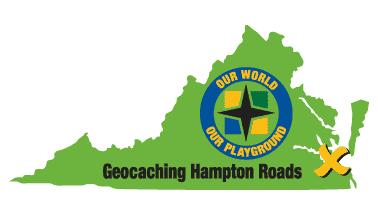The Seven Cities of Norfolk, Portsmouth, Virginia Beach, Hampton Newport News, Chesapeake and Suffolk are defined geographically, economically and historically by the water features that surround us. From the Atlantic Ocean to the Chesapeake Bay and the rivers that form the Chesapeake watershed, to the swamps and other wetlands in the region you would be hard pressed to travel any distance in the region without seeing water, crossing a bridge or going through a tunnel on your journey.
Since the first English Settlers landed at Cape Henry in 1607, human activity in what is now the Commonwealth of Virginia has resulted in the loss of close to half of the wetlands that once existed in the state. Since the 1970's there has been a renewed focus on cleaning our rivers and streams and reclaiming or restoring our wetlands.
The purpose of this Earthcache is to become aware of the importance of wetlands to our lives and to see the efforts, even on a small scale, to reclaim wetlands.
This location is along the Lafayette River in the City of Norfolk. Once known as Tanners creek, the Lafayette River is a tributary of the Elizabeth River and part of the Chesapeake Bay Estuary system. As part of an estuary, the height of the river varies with tidal conditions. This area once consisted of marsh lands that have been filled in to allow the expansion of the City of Norfolk.

The area you are looking at is part of the tidal wetlands system. Within this system there are various components of wetlands that include the marshes, sand beaches, mudflats and the shallow waters of our rivers and creeks. These geographic features provide benefits to the local environment because they:
1. Fillters upland runoff
2. Prevent erosion
3. Absorb higher than normal tides
4. Provide hatchery and nursery areas for fish
5. Provide habitat for birds and animals
6. Provide stop-over locations for migratory waterfowl
In urban settings, such as here in the City of Norfolk, these wetlands also provide flood control to protect our homes, schools and businesses and provide scenic vistas and green areas within the city for us to enjoy.
Unfortunately, wetland areas, especially in urban settings, are often damaged or claimed to support projects for the human poulation of the area. Wetlands are removed to make way for roads, bridges and other infrastructure projects. They are also filled in to allow for the building of residential and commercial structures. In this area, where boating and water activities are very popular, tidal wetlands are often dredged to allow for the establishment of boat channels, marinas and boat ramps. As a result, many areas of the city flood during significant weather events such as Hurricanes, large storms or periods of intense tidal activity due to weather systems off the Atlantic Coast. If you have ever tried to drive through the Larchmont Area of Norfolk during a major storm you are familiar with the flooding of city streets close to the Lafayette and Elizabeth Rivers.

The residents of the city, in conjunction with environmental groups, are in the process of reclaiming wetlands within the city. At this location the project is focused on approximately 1500 square feet of marsh area adjacent to the Lafayette River. While this is not a large tract of wetlands, it is an important project that is raising public awareness of the problem and is proving that restoration of wetlands, even in small parcels, is important to our environment. To claim this EarthCache you will be required to answer some questions about the reclamation of wetlands in this Norfolk neighborhood and provide a photograph to document your visit. The questions you are required to answer are:
1. Looking around this area, what human activities may have led to the loss of wetlands in this location? Give at least two examples of man-made projects, within your line of sight, near this location that would have damaged or destroyed wetlands.
2. Using the information available at the location as well as your powers of observation, what are 3 of the activities that were undertaken to help this wetland area?
3. Who provided grants to make this wetlands restoration project possible?
4. This is optional, based on changes to the rules of geocaching, get a photograph of yourself, your caching party or your GPSr near the brown sign on Colley Avenue that identifies the project area.

Please do not include any spoiler information in your photos or your log. First to find honors go to the first person to successfully email me correct answers and provide photographic evidence of their visit to the location in the log on this page.
I reserve the right to delete any logs that do not comply with the requirements for completing this EarthCache. As with any urban location, please be aware of your surroundings and your personal safety and use good sense when in the area after dark. While this area is not in a "bad neighborhood" in Norfolk, it is always better to err on the side of safety.






Congratulations to hatterasbeaches for FTF honors on this EarthCache!